
When traveling to new areas and fresh waters, it's always wise to hire a guide or find a local who will show you the prime fly fishing areas and let you in on the best fishing flies for that river or stream. But sometimes that's not possible or you may just want to explore a new spot on your own.
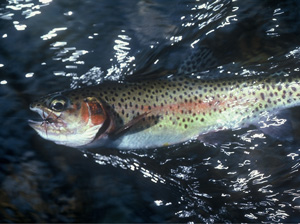 If you choose to explore a new fishing spot, it's good to have a large variety of patterns but also a smaller workhorse group of flies that you turn to most often. These should be flies that have proven themselves many times by producing consistently almost anywhere.
If you choose to explore a new fishing spot, it's good to have a large variety of patterns but also a smaller workhorse group of flies that you turn to most often. These should be flies that have proven themselves many times by producing consistently almost anywhere.
Tip: Learn How to Tie a Trout Winged Ant - watch video
My experience in over 35 years fishing in waters ranging from the Bow River in Canada to the Smoky Mountains in North Carolina, I've come to rely on a dozen proven flies as my go-to patterns for both exploring and saving the day when nothing else seems to work. In fact, these flies have even come through on even more exotic trips to far off locations like the Andes Mountains in Venezuela and the glacier-fed trout streams of Iceland.
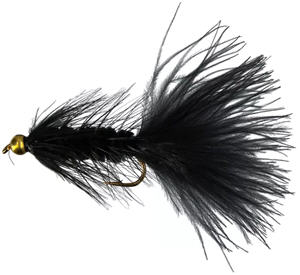
Try These 12 Reliable Fly Patterns - My Workhorse Group of Flies
1. Woolly Bugger Fishing Flies
Sure, we all like to think we'll find trout delicately sipping mayflies from the surface every time we visit a stream. Nature isn't that kind. When it's cold or waters are high and slightly off-color, nothing can beat a streamer. And nothing can top the "buggy" looking Woolly Bugger like White River Fly Shop Bead-Head Woolly Bugger Flies .
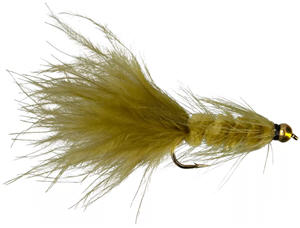
Bugger Flies
This searching fly pattern can mimic baitfish, leeches, baby catfish, crayfish, nymphs and sculpins. It is really a Woolly Worm with a long marabou tail added for bulk and flutter-appeal. Sometimes a few strands of Flashabou are mixed in with the marabou tail.
Top colors are black, olive and brown, best sizes, 2-10. Match the size to the forage or insects you're imitating or gauge it to the size of trout present. You can tie them unweighted for shallow water, but a bit of lead on the shank is usually best so you can work them near the bottom. Try dead drifting and using a slow stripping motion with pauses in deep pools, eddies and runs.
Tip: Shop White River Fly Shop Bead-Head Olive Woolly Buggers , The gold bead head adds weight, flash and color to the Olive Bugger, making it even more enticing to fish.
2. Clouse Minnow Fly

Originated in Pennsylvania to take Susquehanna River smallmouth bass, the Clouser Minnow fly has become legendary throughout the fishing world for its ability to catch just about any species. It's a sparsely dressed pattern with lead eyes that take it deep quickly, making it deadly for bottom-hugging trout.
Stock sizes 2-8 in silver, blue, black and chartreuse colors. Fish them with sharp 12-16 inch strips of the line followed by sudden pauses. I've had everything from tiny native mountain brookies to big deep-river browns rip into these thinly-dressed flies. While you're ordering them, be sure to buy a few extra for bass and saltwater outings.
Tip: White River Fly Shop Clouser Freshwater Deep Minnow Flies are handcrafted streamers with epoxy-protected heads to maintain their finish, while metallic eyes give predators a target to key on.

3. Zonker Fishing Fly
This fly is tied with a Mylar body and a thin strip of rabbit hide and fur on the top called Zonker strips. The Zonker fishing fly gets a bit heavy and cumbersome to cast when saturated. But it's worth the effort.
Huge browns in particular love this fly. Work it deep with a sink-tip line or split shot on the leader. Dead drift it motionless through dark holes and back eddies or twitch it enticingly. Keep the rod tip low to the water for a quick hook-set when a trout nails it, as he surely will.
Pearl, black and olive are top colors, in sizes 2-8. It can imitate a variety of creatures, but primarily is a minnow simulator.
Tip: Shop White River Fly Shop Rabbit Zonker Strips, the strips can be used lengthwise with a straight cut, or cross-cut and wound like a hackle.
4. Classic Hare's Ear Nymphs
Nymphs come in a myriad of designs and shapes, but for a good all-around pattern, stock a selection of these patterns in sizes 6-18. You can use unweighted versions of the tiniest ones to take trout delicately plucking emergers from the surface film or the big patterns with a bit of weight to probe deep pools and runs when no fish are rising. The dull grayish-brown fur is highlighted by a touch of gold ribbing that gives it flash and a natural segmented look.
Use a floating line with an 8-10 foot leader and add a strike indicator near the point where the leader joins the line or slightly closer to the fly if you're fishing shallow water.
Tip: The shaggy look of the Classic Hare's Ear Nymphs fly encourages fish to strike and a favorite of trout anglers.
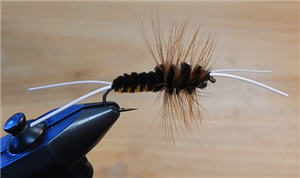
5. Bitch Creek Fly Nymph
This is a terrific stonefly pattern that pounds up big fish on western waters and large eastern rivers. Use sizes 2-6 for those deep water outings. For smaller streams it's also productive in sizes 8-14 when the natural insects are present. Even if they aren't, it's a good all-around pattern that will often stimulate "instinct strikes" when it drifts naturally past a trout's feeding position.
The white rubber legs and antennae add a quivering motion to the fly when it's twitched lightly. Weighted patterns are usually best.
6. San Juan Worm Fishing Fly
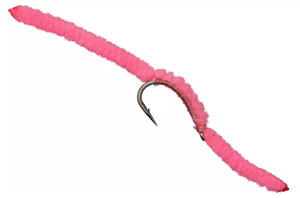
This fly looks so simple you might think it's a joke. You won't think that after you fish the San Juan Worm fly, though. In its most basic form it consists of a piece of chenille tied on a hook so the yarn extends out both the front and back. It's not meant to imitate an earthworm, but it does a good job of that. It actually imitates various aquatic worms.
Fish it dead drift through runs, pockets and pool tail-outs. It's especially deadly in tailwater fisheries. Top colors: red and maroon. Best sizes: 8-12.
Tip: The White River Fly Shop San Juan Worm Flies are extremely effective and catch a lot of fish! San Juans have the same drawing power as a big, fat live worm, every fly angler needs to make room for a few in their fly assortment.

Tip: The White River Fly Shop Masters San Juan Worm Fly Tying Kit contains all materials needed to make 20 great-looking worm flies and includes easy-to-follow, full color step-by-step tying instructions
7. Black Ant Fishing Fly
The fur ant was the original pattern, tied with two oval humps and a thin hackle waist wrapped around between them. That's still a deadly pattern, but you can also tie or buy versions with cork, foam and balsa bodies. Just make sure the waist is thin and pronounced, since that's how trout key in on this common spring-through-fall insect.
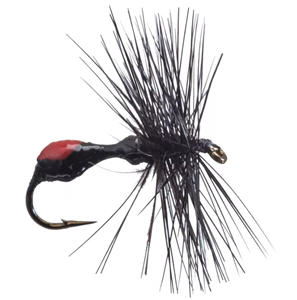
Ants live on land, but like other terrestrials, fall into the water and become an important food for trout. Sometimes mating swarms of ants appear in huge numbers, too. Then a winged pattern works best.
Tip: The Betts Black Ant fly may be the best imitation of a natural insect you've ever tied to a leader. A natural food fish crave, perfect for any fly fisher.
8. Adams Fishing Fly
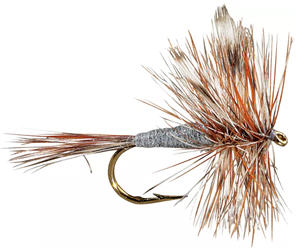
The gray body, brown and grizzly hackle and grizzly-tip wings of the Adams fly pattern imitate a myriad of mayfly species. If you can't match the hatch on a stream, tie on an Adams in the right size to duplicate the emerging mayfly and chances are you'll get plenty of action. Typically sizes 12-18 are best.
Even when caddis are hatching, instead of mayflies, the Adams will draw strikes. When midges are emerging, it's also hard to top a tiny Adams in sizes 20-24. (It's challenging to tie in wings that small, so just skip them from the pattern when creating the fly in these miniscule sizes.)
When mayfly spinner falls take place, have a few Adams patterns handy that you've tied with the wings spread farther out, more parallel to the water. If the trout refuse that fly, take scissors and clip the bottom hackle so the body lies flush on the surface film. Finally, a parachute-tied version is also effective, especially on slick-water, hard-pressured trout.
Tip: The White River Fly Shop Adams dry flies are a great choice anytime mayflies are hatching as well as when mosquitoes, caddis and duns are coming off the water. Adams flies have proven to produce in fast, slow, or still water.
9. Blue Winged Olive Fishing Fly

No other mayfly seems to draw the interest of big trout like the Blue Winged Olive fly. It represents many species, mostly Baetis. Members of this genus can range from size 14-24, so stock a wide variety of sizes. For general workhorse needs, sizes 16 and 18 are best.
Look for hatches as soon as waters reach 50 degrees in early spring. I've had good luck with many styles of tie, including parachute, no-hackle, thorax and comparadun, as well as traditional mayfly styles. For the first part of the hatch, emerger patterns are often best. Look for the best fishing with this fly on drizzly, overcast days. I've even caught big browns on Blue Winged Olives when snow was falling.
Tip: The Blue-Winged Olive fly is a must-have classic trout fly pattern they are so productive that some fly anglers dedicate a whole fly box to house this pattern.
10. Elk Hair Caddis Fishing Fly
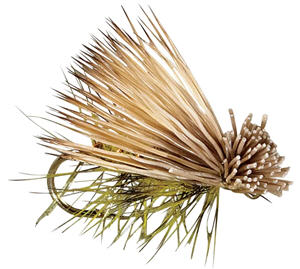
Invented by the legendary Al Troth of Dillon, Mont., the Elk Hair Caddis flies may well be the single most versatile trout pattern in existence. It's definitely one of the top two or three flies you should always have in your fly vest.
I had a chance years ago to watch Al tie a few of these in his home and then try them out on the local Beaverhead River trout with him manning the oars. What a thrill that was. And boy did they produce trout!
Tied with a dubbed body, palmered hackle and elk hair wing, this fly floats like a cork and gives a perfect silhouette of the caddis. It also makes a pretty good grasshopper imitation. Tied without hackle, it can draw strikes from the most finicky of trout in glass-smooth tails of pools. Olive, tan and gray are the top colors, sizes 12-20. If strikes are slow in coming, give it a subtle twitch.
Tip: One of the most effective dry flies of all time, the White River Fly Shop Elk Hair Caddis fly is hard to fish wrong, making it a solid choice when trout are feeding on a wide variety of insects, including stoneflies, mayflies, and, of course, caddis.
11. Hopper Fishing Flies
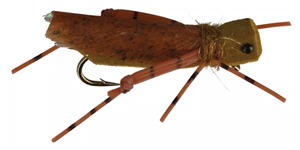
Over recent decades terrestrial insects (born and bred on land), have become more and more important in the diet of trout. Grasshoppers are one of the most significant land insects for trout, partly because of their abundance across the country but also because of their size. A few mouthfuls of fat hopper flies will quickly fill a trout's stomach — a lot faster than hundreds of midges or tiny mayflies.
Wind, rain or simply poorly-timed jumps will land these insects into the river, where they quickly become high-protein trout food. Use patterns such as Joe's, Henry's Fork, MacHopper, Dave's and the Letort Hopper. For early season, a pattern I invented and called the Nymph Hopper works well (Tying & Fishing Terrestrials, Stackpole Books, 1978). The late great author Gary LaFontaine was a strong booster of this pattern for finicky western trout in the early season. It's a simple offering with a rabbit fur body and two splayed deer hair legs angled out and slightly up to float the fly low in the surface film.
Tip: When the hoppers are out late summer in full force the White River Fly Shop Grand Hopper Fly delivers a realistic profile that's soft so it doesn't alert tentative fish, plus the big dry fly rides high on the water so you can keep your eyes on it with ease, making it perfect on its own or as an indicator while nymph fishing.
Be sure to stock several of "terrestrial" fly patterns in your go-anywhere fly box.
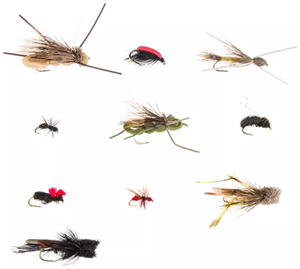
Fly Assortment
12. Beetle Fly Fishing Flies
The humble beetle is the Rodney Dangerfield of trout flies. It's homely looking, plain and doesn't get much respect. But if you want to catch big rainbows and browns, be sure you have this versatile fly in your box for anywhere you fish in the world.
There are over 330,000 species of beetles in existence. Many of them find their way into trout streams where they're quickly gobbled up. You can fish them in mid-stream, but often the best way to fish a beetle is to drop a heavy pattern along shore, next to a bush or under a tree branch, to imitate a real beetle "plopping" in from land. That auditory signal is often what alerts trout and they'll turn, race to the fly and sip it in. Use cork, foam or deer hair patterns such as the Crowe Beetle for this "sound cast."
And hold on tight! Trout up to 2 feet long will nail these squat, chunky patterns any time from April through November.
Tip: The White River Fly Shop Classic Terrestrials Fly Assortment features 10 top patterns, proven to entice a trout to rise even when a hatch is not on.
Assortment includes one fly each:
- #14 Flying Ant Black
- #14 Flying Ant Red
- #14 Lady Bug
- #12 Beetle
- #12 Japanese Beetle
- #10 Dave's Cricket
- #10 Dave's Hopper
- #10 Madam X
- #10 Tan Foam Hopper
- #10 Olive Foam Hopper
Sure, like most anglers I have hundreds of flies in my vest. But when it comes to new waters or tough challenging conditions, these deadly dozen are almost always the ones I turn to most. Keep a supply of them on hand and I think you'll agree they're hard to beat.
- 56347 views

